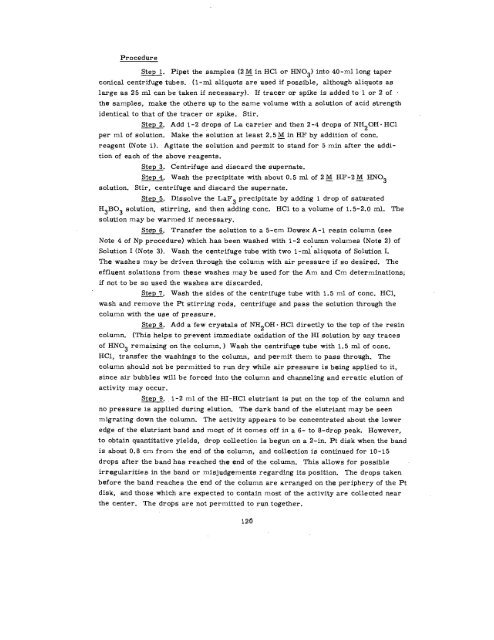THE RADIOCHEMISTRY OF PLUTONIUM - Sciencemadness.org
THE RADIOCHEMISTRY OF PLUTONIUM - Sciencemadness.org
THE RADIOCHEMISTRY OF PLUTONIUM - Sciencemadness.org
You also want an ePaper? Increase the reach of your titles
YUMPU automatically turns print PDFs into web optimized ePapers that Google loves.
Procedure<br />
m. Pipet tie samples (2~in HC1 or HN03) into 40-ml long taper<br />
conical centrifuge tubes. (1 -ml aliquots are used if possible. although aliquots as<br />
large as 25 ml can be taken if necessary). If tracer or spike is added to 1 or 2 of ~<br />
the samples, make the others up to the same volume with a solution of acid strength<br />
identical to that of the tracer or spike. Stir.<br />
=. Add 1-2 drops of La carrier ad then 2-4 drops of NH20H” HC1<br />
per ml of solution. Make the solution at least 2.5 ~ in HF by addition of cone.<br />
reagent (Note 1). Agitate the solution and permit to stand for 5 min after the addi-<br />
tion of each of the above reagents.<br />
=. Centrifuge and discard the supernate.<br />
Step 4. Wash the precipitate with about 0.5 ml of 2 ~ HF-2 ~ HN03<br />
solution. Stir, centrifuge and discard the supernate.<br />
Step 5. Dissolve the LaF3 precipitate by adding 1 drop of saturated<br />
H3B03 solution, stirring, and then adding cone. HC1 to a volume of 1.5- 2.0 ml. The<br />
solution may be warmed if necessary.<br />
=. Transfer the solution to a 5-cm Dowex A-1 resin column (see<br />
Note 4 of Np procedure) which has been washed with 1-2 column volumes (Note 2) of<br />
Solution I (Note 3). Wash the centrifuge tube with two 1-ml’ aliquots of Solution I.<br />
The washes may be driven through the column with air pressure if so desired. The<br />
effluent solutions from these washes may be used for the Am and Cm determinations;<br />
if not to be so used the washes are discarded.<br />
Step 7. Wash the sides of the centrifuge tube with 1.5 ml of cone. HC1,<br />
wash and remove the Pt stirring rods, centrifuge and pass the solution through the<br />
column with the use of pressure.<br />
=. Add a few cryst~s of ~20H” HC1 direc~y to the top of the resin<br />
column. (This helps to prevent immediate oxidation of the HI solution by any traces<br />
of HN03 remaining on the column. ) Wash the centrifuge tube with 1.5 ml of cone.<br />
HC1, transfer the washings to the column, and permit them to pass through. The<br />
column should not be permitted to run dry while air pressure is being applied to it,<br />
since air bubbles will be forced into the column and channeling and erratic elution of<br />
activity may occur,<br />
&I& 1-2 ml of tie HI-HC1 elutriant is put on the top of the col~n and<br />
no pressure is applied during elution. The dark band of the elutriant may be seen<br />
migrating down the column. The activity appears to be concentrated about the lower<br />
edge of the elutriant band and most of it comes off in a 6- to 8-drop peak. However,<br />
to obtain quantitative yields, drop collection is begun on a 2-in. Pt disk when the band<br />
is about 0.8 cm from the end of the column, and collection is continued for 10-15<br />
drops after the band has reached the end of the column. This allows for possible<br />
irregularities in the band or misjudgements regarding its position. The drops taken<br />
before the band reaches the end of the column are arranged on the periphery of the Pt<br />
disk, and those which are expected to contain most of the activity are collected near<br />
the center. The drops are not permitted to run together.<br />
120
















